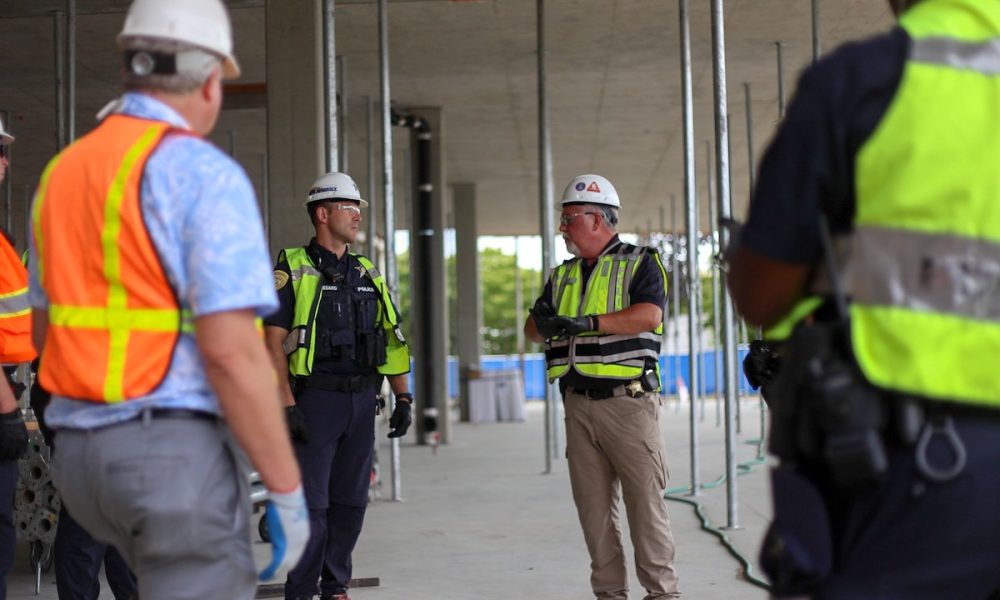 Deputy Police Chief Steve Bellshaw, right, leads a tour of Salem Police Department’s future headquarters on Aug. 2, 2019. (Troy Brynelson/Salem Reporter)
Deputy Police Chief Steve Bellshaw, right, leads a tour of Salem Police Department’s future headquarters on Aug. 2, 2019. (Troy Brynelson/Salem Reporter)
Ricardo Becerril looks at cabinets not as new police storage but pieces to a $58 million puzzle he’s trying to finish.
He’s key to Salem’s ability to control costs that have soared by millions of dollars for the new downtown headquarters for the Salem Police Department.
And that’s where the cabinets come in.
Becerril sees costs in every bracket and drawer slide, bought hundreds at a time and getting more expensive by the day.
Their prices, he said, are “volatile.”
He could well be describing the entire police project.
Contractors broke ground November 2018 and completion is another year away. Costs already have jumped $11 million from what taxpayers were told two years ago.
The causes are complex.
The city is being squeezed by rising costs for everything from bricks to carpenters in a red-hot construction market. It’s an issue compounded by city’s early estimates that started well behind those rocketing costs.
To sort out what happened, Salem Reporter over several months interviewed city officials, contractors and consultants, and examined construction estimates and other city records obtained through public records requests.
What emerged is a story about a city eager to get voter approval for the largest building project in city history, belated recognition of the boom in Oregon’s construction industry, and efforts large and small to squeeze out savings and find more money to get the job done.
Becerril is a project manager at Day CPM, a Beaverton company hired by the city to negotiate with contractors and, ultimately, keep spending in check. He approaches volatile prices like Mr. Clean does mildew: spot it early, try to wipe it out.
“Really, as soon as Day CPM was hired, we were having conversations with the city about how we minimize risk, knowing there was a lot of risk out there in the market,” he said.
Tugs-of-war over pricing occurred all over the project, he said.
Becerril mentioned the cabinetry when asked by Salem Reporter for examples of how he and others dealt with ballooning costs.
To contain costs, project leaders – engineers, construction managers, city officials – put erasers to the blueprints. They nixed built-in cabinets from some rooms, gave other rooms half the cabinets planned, and elected to go with no doors for some cabinets to wring out savings.
“We said ‘How about we do cabinets without doors and turn them into built-in shelves?’” Becerril said. “We customized each location with what the needs are… and hope it leads to better pricing.”
Even after the cuts, Becerril noted, the remaining cabinetry will cost $721,455. That cost is twice what was originally budgeted.
Such triaging wasn’t exclusive to cabinetry, either.
Leaders met for eight hours over two meetings to shave costs on wiring, he said. They decided to eliminate about one-third of electrical outlets in most rooms. Still, that doesn’t change electricians’ pay.
“It’s a little labor savings, but it’s mostly material savings,” Becerril said. At $6.8 million, that specific job came in about $300,000 more than estimated.
Taxpayers have been tapped to help cover the $11 million overruns.
Twice the city has gone into its urban renewal fund, diverting $5.3 million planned for other downtown projects. Another $1.1 million has been pulled from the budgets intended to pay for operations in the police and the public works department.
The remaining costs are made up from contingency funds and extra money the city has made from selling the bonds.
The costs may still not be set in stone. City Manager Steve Powers last month signed a contract with the builder – JE Dunn – finding construction costs shouldn’t exceed $58 million. From here on, cost overruns that should be expected will fall on the contractor to pay.
Still, costs could rise if the city itself decides to make a tweak or if construction encounters an unexpected problem. Allen Dannen, a city engineer on the project, said that can happen, for example, when they dig into nearby streets for improvements.
“To say it’s not going to change from here to the end is probably not realistic either,” he said.
Estimates, then versus now
In 2016, city officials put before Salem voters a plan to replace the cramped police headquarters with a state-of-the-art building.
The city based the request on a cost estimate it paid professionals to generate. They envisioned a three-story station with 148,000-square-foot – like three football fields stacked on top of each other. Salem police have for decades squeezed into 26,000 square feet on the first floor of City Hall, with satellite offices scattered around the city.
The city’s estimate pegged the cost of the new headquarters at $45 million – about $301 per square foot.
The estimator was ACC Cost Consultants, which included a notice about a hyper construction market’s impact on its numbers. The Tigard firm wrote that if construction didn’t start in May 2016, “estimates must be indexed at a rate of 5 to 7 percent per year.”
Voters said no, and the city came back a year later.
This time, voters faced a new question: How about a 115,000-square-foot station? City officials expected they would need almost $39 million – or $338 per square foot. Voters approved.
At the time, however, the city wasn’t working from a final design for the building. According to Deputy Police Chief Steve Bellshaw, officials first wanted to see if the bond passed. When it did, the estimate shared with voters was already outdated, too low to buy the building voters expected.
“As we started looking at it, (contractors said) ‘It’s going to be a challenge to build a 115,000-square-foot building for that price. You need to figure out what you can live with,” he said. “Hence the tours.”
Bellshaw and other project leaders toured new police buildings – one each in Wyoming and Utah and two in Colorado. He called the visits a “real eye-opener.”
“We went to several agencies that had eight or 10 holding cells, and they were using some of them for storage. Building a holding cell is a lot more expensive than building a storage room,” he said. He added that the more they learned what they needed, they shaved off 11,000 square feet – roughly equivalent to five 3-bedroom houses.
But costs were already rising.
By May 2018, new estimates drafted by JE Dunn, the project’s prime contractor, pushed the cost of a square foot of police space from $338 to $405, a 20% jump.
Bellshaw acknowledged the original estimates were too low.
“We wanted to get something passed that we felt was palatable for the voters, when there was all this other pushback about ‘Your estimates are too high,’” he said. “As it turns out, our estimates were probably not high enough.”
But costs continued to escalate, and a January 2019 estimate obtained by Salem Reporter showed the station would cost about $417 per square foot. At those prices, the station building alone will cost $43.5 million – or $5.5 million more than the May 2016 estimate.
 When Salem residents voted to pay for the project, costs were estimated to be $338 per square foot. Costs quickly rose. (Anna CK Smith/Salem Reporter)
When Salem residents voted to pay for the project, costs were estimated to be $338 per square foot. Costs quickly rose. (Anna CK Smith/Salem Reporter)
Those documents show how the cost for some elements increased faster than others. The city would be in even worse position, though, without other costs coming in lower.
Plumbing, for example, went from $1 million to $1.6 million – from less than $10 per square foot to $16. Jobs like excavation, carpentry and flooring inched up, too.
“Across the board, I would say it’s a combination of material commodity prices increasing and actual worker wages — that has definitely gone up,” said Becerril.
Structural concrete, meanwhile, dropped nearly $8.7 million to $6.7 million – or from $83 per square foot to $64 — as bids came in lower than expected, Becerril said. Heating and air conditioning also fell nearly $1 million after it was found to be “significantly over budget.”
Cut or keep
In June, Becerril went to the third floor of City Hall to talk with leaders about rising costs.
One of his presentation slides graphed like a craggy slope the construction costs in Portland over the past decade. As an example, it claimed that the cost of paying excavators jumped 12% in just three months.
“That’s snowballing-out-of-control escalation,” he told the leaders. “It’s hard to keep up with that.”
The meeting was one of five this year for the city’s Police Facility Council Committee. Four city councilors meet with staff and Becerril to discuss the construction. It’s there that issues about the prices are raised in a public forum.
Reconciling those costs with the need for both public safety and financial responsibility has been an ongoing battle, according to Councilor Chris Hoy.
“The staff and the contractor have done, I think, a good job of trying to cut where they can and still honor the commitments for a police station that meets the needs of police for the next several years,” he told Salem Reporter.
A retired undersheriff of Clackamas County, Hoy said city officials made cuts where they could, but resisted cutting some amenities if it meant hurting policework. One example is a $120,000 system to keep the parking garage ramps from freezing.
“Is that a must-have? You could argue maybe not, but you could argue ‘Do we want police to slip and slide as they come down the (garage) ramp? Or do we want them focused on getting to the call?’” he said.
A few other amenities have added to the building since the original planning. Last October, police officials wanted an 85-inch Mondopad, basically a giant iPad that costs $22,655. By May, they decided to buy four.
Bellshaw said the police already have one of the devices and now plan on having at least one per floor at the new station. He said in a situation like a recent officer-involved shooting, the giant screens make it easier to orchestrate through chaos.
“I can keep track of where all my officers are, especially around something like that when we have officers coming from Keizer, Marion County, Polk County, all over the place, coming to help,” he said.
Police are also looking to put $4,600 icemakers on each floor, according to the latest construction figures. Bellshaw said those are necessary for the same reasons the city intends to spend nearly $30,000 on commercial washers and dryers – the police station is a home away from home. He said big cases might keep officers on duty there up to 20 hours.
“This is their home for that time. This is where they’re eating those meals. This is where they are stuck while writing reports or search warrants or whatever it is. At 2 a.m., their choice of places they can go are pretty limited. A lot of them eat here, work out here after their shift, those kinds of things,” he said.
To cover the escalating costs, Hoy and other councilors agreed to take $5.3 million from its downtown urban renewal fund. City officials justified the move as helping the police station pay for bathrooms that can be accessed at all hours and help the city’s homeless population, as well as other community benefits.
“The bottom line is we’re in a really hot market. There’s a lot of building going on in Salem, in Oregon, and nationwide. That’s a good thing in that there’s a lot going on, but the downside is that it raises labor costs and makes it harder to find people to do the work,” Hoy said. “That’s not unique to the city.”
The bottom line
Subcontractors say they are in fact ratcheting-up costs on projects because their costs are rising, too.
Sheets upon sheets of metal siding – approximately 20,000 square feet for the police station – cost up to 4% more every three months for Arctic Sheet Metal. Today they cost close to $60 per square foot, the estimates show.
“It would be like I went to the store three years ago and milk was three bucks, and I went there yesterday and milk was five bucks,” said Eric Miller, an architectural manager with the company. “That’s the trend we’re seeing, if you want to see it in layman’s terms.”
Also heading to the station are 22,000 bricks the color of dark iron and 20,000 gray cinderblocks, costing about $1.30 and $1.85 apiece. That’s according to Kraft Masonry’s estimator Mike Rasmussen.
Materials like that are going up, Rasmussen said, because the brick-makers they buy from are also overworked – it just cascades from there.
“Every contractor is overworked, every manufacturer is overworked,” he said.
The phenomenon is more pronounced in the region, Miller said. In the Portland area, many cities, counties, public agencies and schools are embarking on large construction projects.
Manpower remains at a premium, he said. Low unemployment means workers can find better paying jobs much easier.
“When the economy is good, what happens is that everybody who is worth anything has a job,” Rasmussen said. “As you want to grow, it’s harder to grow because you don’t have the people out there you need. There’s a shortage of labor, of masons.”
The latest public wage data compiled by the U.S. Department of Labor backs up that view. In Salem, the average construction worker made $50,380 per year, up 15% from $43,970 in 2013. Brick masons earn an average of $68,330 – up 20% from $56,910.
Rasmussen and Miller said costs are up, but couldn’t say whether their firms are seeing more profits.
One subcontractor who bids public construction projects, but did not win a contract for Salem’s police station, said he is profiting more in the current market. He said for many in construction, after the famine of last decade’s recession, it’s time to feast.
Carl Harbaugh founded South Town Glass in his garage in 1971, crafting his business cards over old recipe cards. He took an emergency loan during the recession that he’s still paying off.
“Gotta make hay when the sun shines,” he said. “The schools, I owe them. Everything I‘ve got now has been because of the school district. I wouldn’t have survived.”
Have a tip? Contact reporter Troy Brynelson at 503-575-9930, [email protected] or @TroyWB









